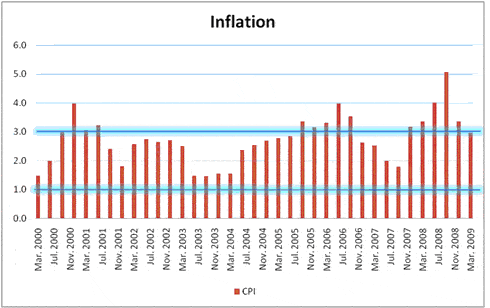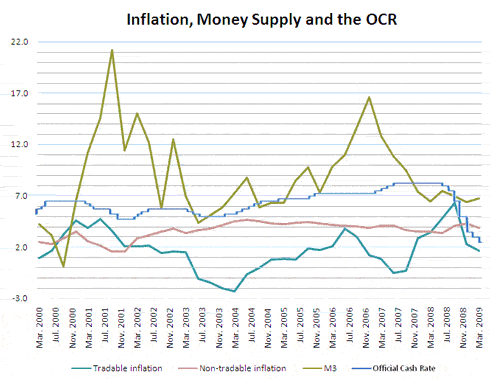 By John Walley I recently attended the New Zealand Association of Economist's Annual Meeting where there was a good deal of discussion around the causes of the financial crisis, and how our own approach to monetary policy operated and resonated with the choices of other jurisdictions. David Preston offered a good appraisal of our monetary policy in his presentation entitled Putting Credit Back into Monetary Policy. His argument was that if you measure the success of monetary policy only by the objectives set out in the Policy Targets Agreement then it has been fairly successful, but if you measure success according to wider economic objectives then it has failed. A quick look at this inflation chart would lead to the conclusion that the Reserve Bank has kept inflation in the target band over the medium term. A success? Well, Maybe.
By John Walley I recently attended the New Zealand Association of Economist's Annual Meeting where there was a good deal of discussion around the causes of the financial crisis, and how our own approach to monetary policy operated and resonated with the choices of other jurisdictions. David Preston offered a good appraisal of our monetary policy in his presentation entitled Putting Credit Back into Monetary Policy. His argument was that if you measure the success of monetary policy only by the objectives set out in the Policy Targets Agreement then it has been fairly successful, but if you measure success according to wider economic objectives then it has failed. A quick look at this inflation chart would lead to the conclusion that the Reserve Bank has kept inflation in the target band over the medium term. A success? Well, Maybe.
 If we look a little deeper and disaggregate the inflation of the tradeable and non-tradeable sectors and add a few other characteristics, we see a very different picture.
If we look a little deeper and disaggregate the inflation of the tradeable and non-tradeable sectors and add a few other characteristics, we see a very different picture.  It would seem the Official Cash Rate (OCR) has little impact on inflation in the non-tradeable sector. Non-tradable inflation is consistently outside the target band. Tradeable inflation has fluctuated wildly over the same period, but has averaged only 1.7 percent, well within the target band. Monetary policy has constrained the tradeable sector via interest rates and the secondary but major impact of the exchange rate. The non-traded economy that is responsible for inflationary pressures has been largely unaffected by the OCR. As Preston noted, the price of credit moved up with the OCR but this was also a period of rapid credit expansion. From May 2004 to May 2009 the money supply expanded at an average of 8.9 percent. Our high interest rates allowed banks to source credit from overseas to fund local asset backed borrowing. Borrowers were largely undeterred by the interest costs because asset prices continued to rise, (well supported by their asset tax haven status) more than offsetting the higher interest bill. So what can we see:
It would seem the Official Cash Rate (OCR) has little impact on inflation in the non-tradeable sector. Non-tradable inflation is consistently outside the target band. Tradeable inflation has fluctuated wildly over the same period, but has averaged only 1.7 percent, well within the target band. Monetary policy has constrained the tradeable sector via interest rates and the secondary but major impact of the exchange rate. The non-traded economy that is responsible for inflationary pressures has been largely unaffected by the OCR. As Preston noted, the price of credit moved up with the OCR but this was also a period of rapid credit expansion. From May 2004 to May 2009 the money supply expanded at an average of 8.9 percent. Our high interest rates allowed banks to source credit from overseas to fund local asset backed borrowing. Borrowers were largely undeterred by the interest costs because asset prices continued to rise, (well supported by their asset tax haven status) more than offsetting the higher interest bill. So what can we see:
- The exchange rate has fluctuated wildly as global capital flows chase our OCR movements.
- A large proportion of debt in New Zealand has flowed towards asset tax havens (land and buildings) where the increased interest costs could be covered: that caused the imbalance we see in our economy.
- The OCR has next to no impact on the non-traded economy.
These problems will continue until the rules change. The attempts to control inflation have failed; inflation has only been brought within the target band by almost killing the tradeable sector while inflation in the non-traded economy is demonstrably impervious to interest rates pressure. So what is worth discussing?
- How can we better deal with non-traded sector inflation?
- What are the factors that might impede such changes?
I hope this seeds a good set of discussion. ____________ * John Walley is the CEO of the New Zealand Manufacturers and Exporters Association.
We welcome your comments below. If you are not already registered, please register to comment.
Remember we welcome robust, respectful and insightful debate. We don't welcome abusive or defamatory comments and will de-register those repeatedly making such comments. Our current comment policy is here.